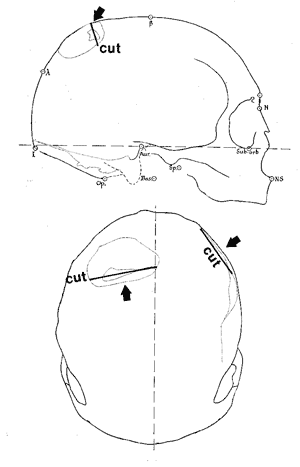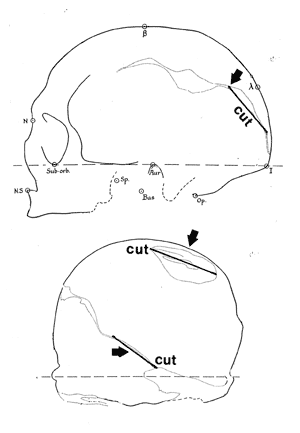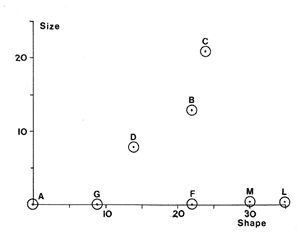


One hundred and fifty years of human skeletal studies in Orkney |
|||||||
When I arrived in the Orkneys in the late 1960's to investigate burials washing out into the sea in Deerness, I had no idea of the long tradition of antiquarianism in Orkney. Daphne joined the excavation in Newark Bay, and was one of the individuals who helped in my Orkney education. I also began to read and collect Orkney literature, and slowly realised the richness of Orkney archaeology, Natural history, folklore and cultural history. I even indulged in regional studies of Orkney gravestones (Brothwell, 1972), realising eventually that, in genetic terms, each cemetery had its own family predominances, and this must have been no less the case in the past, in Norse times or back into prehistory. Orkney records were also a fruitful source of information on morbidity well back into the nineteenth century. It was especially sad to see that, in such apparently ideal natural environments, tuberculosis was a serious killer of the young. How long ago did human remains attract attention in Orkney? The answer of course extends into unwritten history, and perhaps the Norsemen who dropped into Maeshowe made comment on the bones lingering there. By the middle of the nineteenth century, George Petrie an Orkneyman with an interest in the past was exploring Orkney tombs. In 1863, a tomb stated to be like Maeshowe was disturbed by workmen In Burray and produced parts of 72 human skeletons and the skulls of dogs (Wilson, 1863). Since then, a number of Neolithic tombs have yielded human skeletal material, including Isbister and Quanterness, and following metrical studies it is clear that these northern people had a phyique similar to their contemporary English relatives. Short cists were also being discovered, and the usually singular burials began to be collected in the university museums in Aberdeen and Edinburgh . In phyique, these Bronze Age people surprisingly were taller and more robust than the earlier islanders. Iron age remains have remained extremely elusive, both in Orkney and Scotland, although a skeleton found in 1825 at a broch in Evie could be one of the few individuals so far found. Bog bodies in Britain also appear to have dates ranging from the Iron Age to more recent times, and a few known cases discovered in Orkney could represent this time span. James Hunt, in a review of British peat bodies (1866) describes the range of preservation. The Orcadian of 1864 gives an account of a body considered to be that of Mary Linklater, murdered 250 years before that date. While the bones were soft, her hair and clothing - and even her brain, were in good condition (Mackintosh, 1967). History records that she was killed by a blow to the head with a sword, but on her recovery from the peat, no mention was made of the injury.
I have long considered the head injuries of a more famous Orcadian, Saint Magnus. Professor R.W.Reid of Aberdeen had an opportunity to examine the supposed skeleton in 1925, reporting on it a year later (Reid, 1926). According to the Orkneyinga Saga, he was stuck twice on the head with an axe, and the question is whether the damage on the skull supports the view that:
The saga also states that the executioner stood in front of Magnus, which would have influenced the form and position of bone damage on the skull. Looking at the injuries described and illustrated by Reid, neither seems to 'fit' with axe blows from the front of the individual. The evidence is as follows: A relatively short straight cut to the right parietal is nearly at right angles to the median plane, and only just enters the endocranial surface. It looks as if the blow splintered off a posterior half-moon piece of parietal. (Figure 1) There is a long irregular crack on the left side of the skull which extends down onto the right side of the occipital. It is too long for an axe cut, but the weapon could have been driven in and caused extra tension splitting. The problem is that there is no obvious straight axe cut to be seen, although this may be due to the erosion of a somewhat straighter area in front of the lambdoid suture. (Figure 2). Neither of these two possible injuries, if they are indeed trauma evidence, could have been received from axe blows directed down from the front, and this calls into question either the authenticity of the skull or the position of the executioner. This brings us to the Norse period, where infact little was known of the biology of the population until a rescue excavation in Deerness, which Daphne contributed to, began to provide some information on these people. The poorly excavated St. Ninians (Shetland) skeletal remains also provided Norse material from another part of the northern isles. Figure 3 shows just a few of the results of comparing the Newark Bay population with a number of other groups, from Scotland, Ireland, Scandinavia and northern England. It was no surprise to see the pre-Norse Iron Age sample so very different.
It was also something of a relief to see the Oslo medieval series quite close in terms of metric similarities. But in some ways, there was more variation than expected, and in particular the St. Ninians sample was far more separated from the Orkney series than expected. Sample size may have influenced the difference, but again I suspect that family distinctiveness in the Viking families peopling different parts of the northern isles may also have been an influence. Founder effect is a biological phenomenon which should not be forgotten when explaining such differences in early British populations. So Orkney has contributed significantly to the study of early British populations, and Daphne Lorimer has her place in the history of studies on ancient Orcadians. What is now needed is a new generation of Orkney archaeologists who will go in search of further evidence, and perhaps especially find the graves of the Iron Age folk and more regional samples of the Norse settlers. References
|
|||||||




